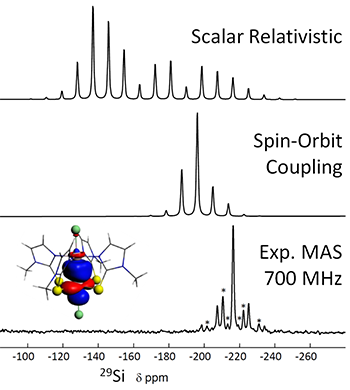Pt σ-donation induces strong relativistic effects on 29Si NMR
Relativistic effects usually scale with the square of the atomic number, thereby really affecting the chemical structure and reactivity of heavy elements. If a light atom is interacting with a heavy atom, however, it can inherit relativistic effects: the heavy-atom effect on light atoms (HALA). In a combined experimental and theoretical study, Truflandier et al. have prepared and analyzed a triad of complexes with a σ-donating bond of transition metals (Ni, Pd, Pt) to Si: TM→Si. Bond decompostion and NBO analyses confirm the dative bond from Ni, Pd or Pt to Si, although a significant covalent interaction exists for the Pt complex.
The 29Si NMR signal is particularly shifted upfield for all these TM→Si complexes, much more than for model hypervalent Si compounds. Relativistic DFT calculations with ADF’s ZORA Hamiltonian revealed that scalar-relativistic calculations are insufficiently accurate to reproduce the observed NMR properties. Without spin-orbit coupling all three d8 metals would induce approximately the same shieliding. However, with the full spin-orbit coupling ZORA Hamiltonian strong shielding of 29Si is observed, improving the agreement with experiment, especially for the Pt complex. The calculated 1JPt,Si coupling constant is also in agreement with the experiment.

Heavy-atom effect on a light atom: a dative Pt bond strongly shields Si. The experimental 29Si NMR spectrum of a Pt→Si complex can only be reproduced with full spin-orbit coupling calculations. Stars indicate spinning side bands and 195Pt satellites.
spin-orbit coupling, NMR, bonding analysis, NBO
L. A. Truflandier, E. Brendler, J. Wagler, J. Autschbach, 29Si DFT/NMR Observation of Spin-Orbit Effect in Metallasilatrane Sheds Some Light on the Strength of the Metal→Silicon Interaction Angew. Chem. Int. Ed. 50, 255 (2011)
Key conceptsADF bonding analysis inorganic chemistry NMR Relativistic DFT spectroscopy